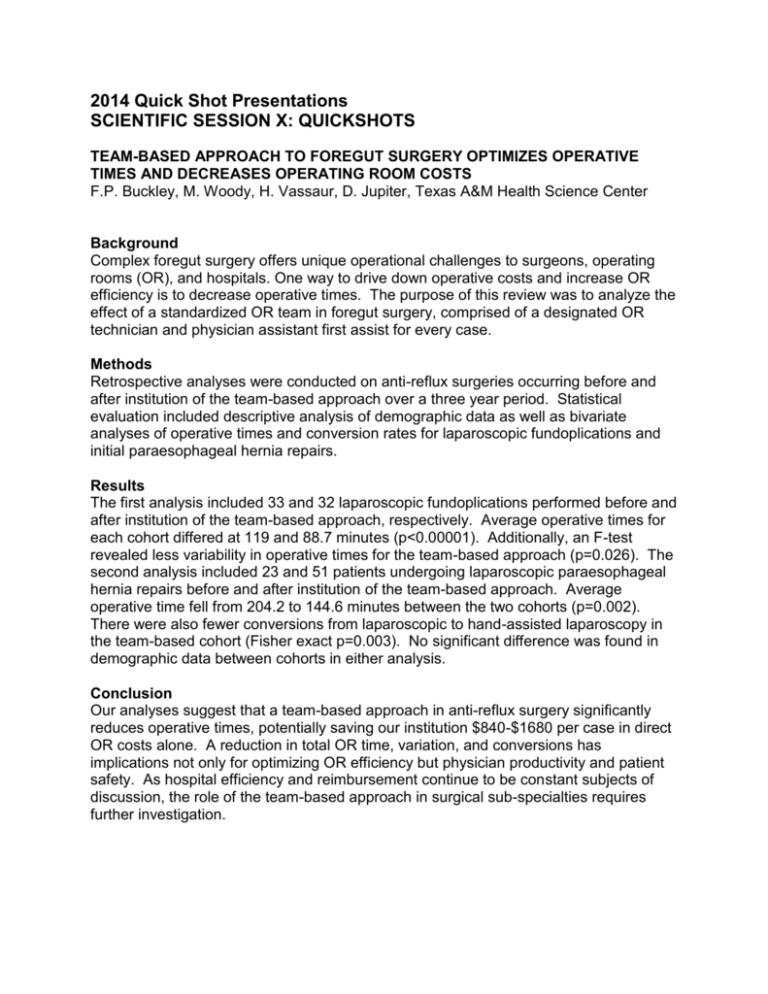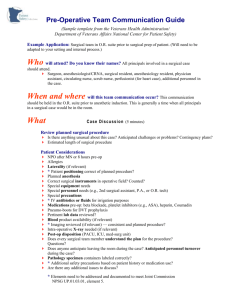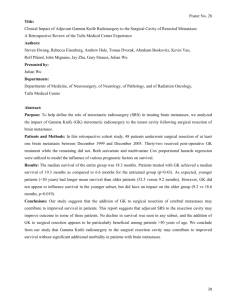session x: quick shots
advertisement

2014 Quick Shot Presentations SCIENTIFIC SESSION X: QUICKSHOTS TEAM-BASED APPROACH TO FOREGUT SURGERY OPTIMIZES OPERATIVE TIMES AND DECREASES OPERATING ROOM COSTS F.P. Buckley, M. Woody, H. Vassaur, D. Jupiter, Texas A&M Health Science Center Background Complex foregut surgery offers unique operational challenges to surgeons, operating rooms (OR), and hospitals. One way to drive down operative costs and increase OR efficiency is to decrease operative times. The purpose of this review was to analyze the effect of a standardized OR team in foregut surgery, comprised of a designated OR technician and physician assistant first assist for every case. Methods Retrospective analyses were conducted on anti-reflux surgeries occurring before and after institution of the team-based approach over a three year period. Statistical evaluation included descriptive analysis of demographic data as well as bivariate analyses of operative times and conversion rates for laparoscopic fundoplications and initial paraesophageal hernia repairs. Results The first analysis included 33 and 32 laparoscopic fundoplications performed before and after institution of the team-based approach, respectively. Average operative times for each cohort differed at 119 and 88.7 minutes (p<0.00001). Additionally, an F-test revealed less variability in operative times for the team-based approach (p=0.026). The second analysis included 23 and 51 patients undergoing laparoscopic paraesophageal hernia repairs before and after institution of the team-based approach. Average operative time fell from 204.2 to 144.6 minutes between the two cohorts (p=0.002). There were also fewer conversions from laparoscopic to hand-assisted laparoscopy in the team-based cohort (Fisher exact p=0.003). No significant difference was found in demographic data between cohorts in either analysis. Conclusion Our analyses suggest that a team-based approach in anti-reflux surgery significantly reduces operative times, potentially saving our institution $840-$1680 per case in direct OR costs alone. A reduction in total OR time, variation, and conversions has implications not only for optimizing OR efficiency but physician productivity and patient safety. As hospital efficiency and reimbursement continue to be constant subjects of discussion, the role of the team-based approach in surgical sub-specialties requires further investigation. AGREE TO DISAGREE: LACK OF STANDARDIZED INDICATIONS FOR CONGENITAL DIAPHRAGMATIC HERNIA REPAIR LEADS TO SIGNIFICANT INSTITUTIONAL VARIABILITY Hollinger L, Lally KP, Wilson JM, Tibboel D, Midrio P, Levy SM, Lally PA, Tsao K for the Congenital Diaphragmatic Hernia Study Group, University of Texas Health Science Center at Houston Background Congenital diaphragmatic hernia (CDH) presents with a spectrum of disease severity and associated anomalies. Despite adopted treatment algorithms, the threshold to offer surgical repair remain institution-dependent. We sought to characterize the cohort of infants that did not undergo CDH repair as well as non-repair rates among institutions. Methods Data were abstracted from an international, multicenter, prospectively collected registry of live-born CDH infants. Estimates of survivability and decision for not repairing the CDH were locally determined by participating institutions. Institutional non-repair rates were compared utilizing only high-volume centers (> 10 CDH infants/ year during the study period). Chi squared and t-test analysis were utilized with statistically significant at p<0.05. Results 2,570 infants with CDH were identified from 65 centers over a seven-year period. 14 high-volume centers were selected with a median non-repair rate of 16.5% (range 9.3% - 29.9%) totaling 1,275 patients. Patients who did not undergo repair were significantly more premature (35.9 vs 37.6 weeks), lower birthweight (3.5 vs 3kg), had lower 5 minute APGAR scores (5 vs 7), were more often prenatally diagnosed (83.2% vs 67.2%), and were more likely to have major cardiac (19 vs 5.9%) or chromosomal (12 vs 4.5%) anomalies. Of the 210 infants who did not undergo repair, reasons for nonrepair included: inability to stabilize (30%), non-survivable/not ECMO candidate (33.8%), survivable/not ECMO candidate (3.9%), survivable/placed on but died on ECMO (21.3%), and came off ECMO, but not repaired (11.1%). Conclusion Significant differences among repaired and non-repaired CDH infants exist. The higher proportion of infants with major associated anomalies among non-repaired patients suggests either a pre-selection of healthier infants prior to transfer, or demise of unstable infants during transport. The wide range of non-repair rates, even among highvolume centers, suggests significant variation in treatment approaches among institutions and lack of consensus regarding viability. TRANSPLANTATION IN A PATIENT WITH CONGENITAL ABSENCE OF PORTAL VEIN: A CASE REPORT Sherilyn Gordon-Burroughs, M.D, Julius Balogh, Morris A. Weiner, M.D., Howard P. Monsour Jr., M.D., R. Mark Ghobrial, M.D. PhD., Houston Methodist Hospital Background Congenital absence of the portal vein (CAPV) is a rare congenital anomaly in which the superior mesenteric (SMV) and splenic veins converge and bypass the liver draining directly into the inferior vena cava (IVC). Portosystemic shunting causes clinical manifestations of hepatic encephalopathy as well as a predisposition to focal nodular hyperplasia/adenoma and hepatocellular carcinoma by the disruption of enterohepatic blood flow. Historically, CAPV has been a rare condition found mainly at autopsy, however in recent years due to the advances in radiological techniques the detection of CAPV has increased. (89) Brief statement of methods A 61 year-old female with a medical history of adenomatosis of the liver and surgical history of previous left hepatic segmentectomy presents with recurrent HCC. She is evaluated for transplantation and found to have congenital anomalous portal vein on pre-operative imaging. In May 2011, she underwent an orthotopic liver transplantation. (50) Summary of results Interval follow-up post transplantation shows no evidence of HCC. An MRI performed 5 months post-transplant shows no evidence of suspicious hepatic lesions as well as a patent hepatic and portal veins. (31) Statement of Conclusion Clinical presentation of CAPV is extremely variable ranging from presentation with severe metabolic derangements and early childhood demise, in contrast to this case in which there were no metabolic complications but the presentation of recurrent HCC after resection. Treatment options for Type I Abernathy malformations in patients who present with liver dysfunction, focal nodular hyperplasia or tumor include either tumor resection or liver transplantation. Patients with Type II Abernathy malformations who present with porto-systemic encephalopathy, or portal hypertension and have symptoms should be treated via either surgical ligation or interventional embolization. Liver transplant is a viable option in patients who can safely undergo the procedure, but long term follow-up on this cohort of individuals needs to be done. (118) THE ROLE FOR SUPERSELECTIVE ANGIOEMBOLIZATION IN LOWER GASTROINTESTINAL HEMORRHAGE: A REVIEW OF THE LITERATURE AND DISCUSSION OF NEW TECHNICAL AND CLINICAL CONSIDERATIONS Rashidi, L.; Cheng, C.Silva, M.; Gajjar, A., University of Texas Medical BranchGalveston Background Lower gastrointestinal bleeding (LGIB) is a common clinical entity seen by surgeons. 75-80% of cases, bleeding ceases without surgical intervention, however, 10–15% of patients with LGIB require intervention to arrest the bleeding. Historically, surgical treatment of LGIB with bowel resection was associated with a high mortality rate. Superselective angio-embolization (SSAE) has been proposed as an alternative or adjunctive treatment in these patients. We review the current literature and present our technique and equipment choices, use of intestinal marking agents, provocation protocols and clinical considerations for interval resection and follow-up. Methods Systemic review by electronic literature searches (MEDLINE, PUBMED) was performed for studies published from 1985 through 2011. Case series analysis was undertaken of patients who underwent arterial embolization for LGIB. Results SSAE at our institution is performed by the vascular surgery service in conjunction with the colorectal service. Our technique uses a .014” telescoping catheterization with coil embolization of the identified bleeding source. In select cases, provocation with thrombolytic agents and heparin anticoagulation are used to identify the bleeding source. Infusion of methylene blue is used to assist in identification of the site for surgical extirpation if required. While these techniques have proven effective and successful, complications have been encountered including failure to identify a source, rebleeding, ischemia or stricture requiring surgical intervention. Conclusion SSAE should be an integral part of the diagnostic and therapeutic management of patients presenting with LGIB. We discuss our techniques for identifying and provoking the bleeding source with intentional staining to assist in locating the diseased segment and limit the amount of resection required. These techniques may be definitive, be performed in anticipation of immediate resection or be used as a bridge to a ‘semielective’ resection if required. Surgeons should learn these SSAE techniques and carry a high degree of suspicion for early and late-onset complications. MORBID OBESITY, SOLID ORGAN FAILURE AND TRANSPLANTATION Robert Davis M.D.,F.A.C.S., THe Davis Clinic Background Morbid obesity has a close relationship to chronic solid organ failure. Hepatic and renal failure may improve remarkably after bariatric surgery. A high BMI will not allow patients to be considered as candidates for transplantation. Methods 4 patients were referred for bariatric surgery. They ll had BMIs over 42 and had chronic renal failure. Results All 4 patients had a Roux-en-Y gastric bypass. Their perioperative course was unremarkable except for one patient who required prolonged hospitalization for pulmonary insufficiency. Conclusion All of the patients lost weight at an average of 10 lb per month and all were successfully transplanted when they met criteria. ELDERLY TRAUMA PATIENTS CAN BE SAFELY ADMITTED TO THE SURGICAL WARD OR INTERMEDIATE CARE UNIT WITH ACCEPTABLE OUTCOMES Trust M, Ali S, Brown C, University of Texas Southwestern - Austin Background Trauma centers across the United States are caring for elderly trauma patients with greater frequency every year. At baseline, elderly trauma patients often have abnormal physiology and medical comorbidities. For these reasons, some authors have concluded that elderly trauma patients should always be admitted to the highest level of care to maximize outcomes. Methods Retrospective study of elderly (>/= 70 years old) trauma patients admitted to our trauma center (2005 - 2011). After excluding patients who were deemed to have injuries that were terminal and irreversible at presentation and were admitted for comfort measures only, we compared elderly trauma patients who were admitted to the ICU vs. IMC vs. surgical ward. Results 1,560 elderly trauma patients were admitted to our trauma center, 371 (24%) were admitted to the ICU, 454 (24%) to the IMC, and 735 (47%) to the surgical ward. When comparing patients admitted to the ICU vs. IMC vs. surgical ward there were differences in admission systolic blood pressure (140 vs. 147 vs. 149, p < 0.001), pulse (89 vs. 83 vs. 81, p < 0.001), and GCS (13 vs. 15 vs. 15, p < 0.001) and patients admitted to the ICU had a higher ISS (21 vs. 13 vs. 9, p < 0.001). Mortality among patients admitted to the ICU was 12% (n = 44), while mortality was much lower for patients admitted to the IMC (2%, n = 7) and surgical ward (1%, n = 6), p < 0.001. Only 1% (n = 10) and 2% (n = 11) of patients admitted to the surgical ward and IMC respectively required transfer to a higher level of care. Conclusion Elderly trauma patients can be selectively admitted to the surgical ward or IMC with acceptable outcomes and potential cost savings, reserving ICU admission for more severely injured elderly patients. How Distance from Specialized Transplant Centers and Residence in Rural and Urban Setting Affects Outcome of Liver Transplant Patients on Waitlist in the USA. Zorzi D, Jennings K, Rastellini C, Cicalese L, UTMB Background Patients listed for liver transplant in United Network of Organ Sharing (UNOS) Region 4 (Texas and Oklahoma) have higher wait list mortality when residing >30 miles from specialized transplant centers (TxC). We sought to investigate whether these findings are confirmed in the entire United States (US) and if differences were observed between rural and urban areas. Methods All patients registered with UNOS as candidates for liver transplant in the US from 2002 to 2012 were stratified by distance from the patient’s residence to the closest TxC and by Rural Urban Commuting area codes (RUCA) classification. Mortality risk on the waiting list and likelihood to receive a transplant were analyzed using a generalized additive model (GAM) with Bayesian Information Criterion (BIC). Results Of the 63,242 patients included in the study, 55% resided <30 miles from a TxC; When using RUCA distribution the majority of listed patients resided in metropolitan areas (82%); the remaining 18% distributed between micropolitan and rural areas. A GAM for 90 day mortality and for probability of death versus transplant using distance to TxC showed significant increased risk with the distance (p=0.0011 and p<0.001, respectively). On the contrary the GAM for 90 day mortality and for probability of death versus transplant using RUCA did not show significance (p=0.297 and p=0.947 respectively). Conclusion Patients residing at greater distance from a TxC are at higher risk of dying on the waiting list within 90 days from listing and at lower likelihood to receive an organ while RUCA classification is not indicative of predicting mortality if distance from TxC is not considered.. These data suggest that the variable “distance from a TxC” should be used to improve the estimate of the mortality risk for patients on the waiting list for liver transplant. Regional variation for the GAM should be individually analyzed. IDENTIFYING THE OPTIMAL NUMBER OF CYCLES OF CHEMOTHERAPY PRIOR TO SURGICAL RESECTION IN HIGH-RISK NEUROBLASTOMA Rojas Y, Jaramillo S, Lyons K, Mahmood N, Wu J, Liu H, Vasudevan S, Guillerman RP, Louis C, Nuchtern JG, and Kim ES., Baylor College of Medicine/ University of Texas Medical Branch Background Treatment of high-risk neuroblastoma (HRNB) remains a clinical challenge secondary to continued poor prognosis despite dose-intensive, multi-modal therapy. The most recent cooperative group trial for HRNB recommends surgical resection after the 4th or 5th cycle of induction chemotherapy, leaving the decision to healthcare providers. We therefore wanted to determine if the number of chemotherapy cycles prior to surgical resection affects surgical and survival outcomes in HRNB patients. Methods After IRB approval, we retrospectively reviewed records of patients <18 years old diagnosed with HRNB at our institution from 2000-2010. Patients were stratified by the number of chemotherapy cycles received prior to surgical resection. Data were summarized and compared between groups using non-parametric Wilcoxon rank-sum test or Kruskal-Wallis test for continuous variables and Fisher’s exact test for categorical variables. Kaplan-Meier analyses were used to estimate OS and EFS. P-value <0.05 was considered significant. Results Sixty HRNB patients were evaluated: median age at diagnosis was 2 years (range 5.3 months-8 years) and 47% were female. Surgical resection occurred in 17% (10) prior to cycle 1; and after cycle 2 in 10% (6), cycle 3 in 33% (20), cycle 4 in 22% (13) and cycle 5 in 18% (11). The median percent tumor reduction was significantly higher in patients who received 4-5 cycles compared to 2-3 cycles (84.1% (0-98.4%) vs. 77.6% (-22.196.6%), respectively, p<0.0001). Those who received 4 cycles had superior 5-year OS (83%, 95%CI:46-95) compared to 0 (50%, 95%CI:13-79), 2 (33%, 95%CI:5-68), 3 (45%, 95%CI:22-67), and 5 cycles (36%, 95%CI:11-63). No significant differences were observed based on MIBG score, MYCN status, extent of tumor resection, intra- and post-operative complications, and length of stay. Conclusion Our findings suggest HRNB patients who undergo 4 cycles of chemotherapy prior to surgical resection have a superior OS and although the reasons remain unclear, further studies are warranted.





